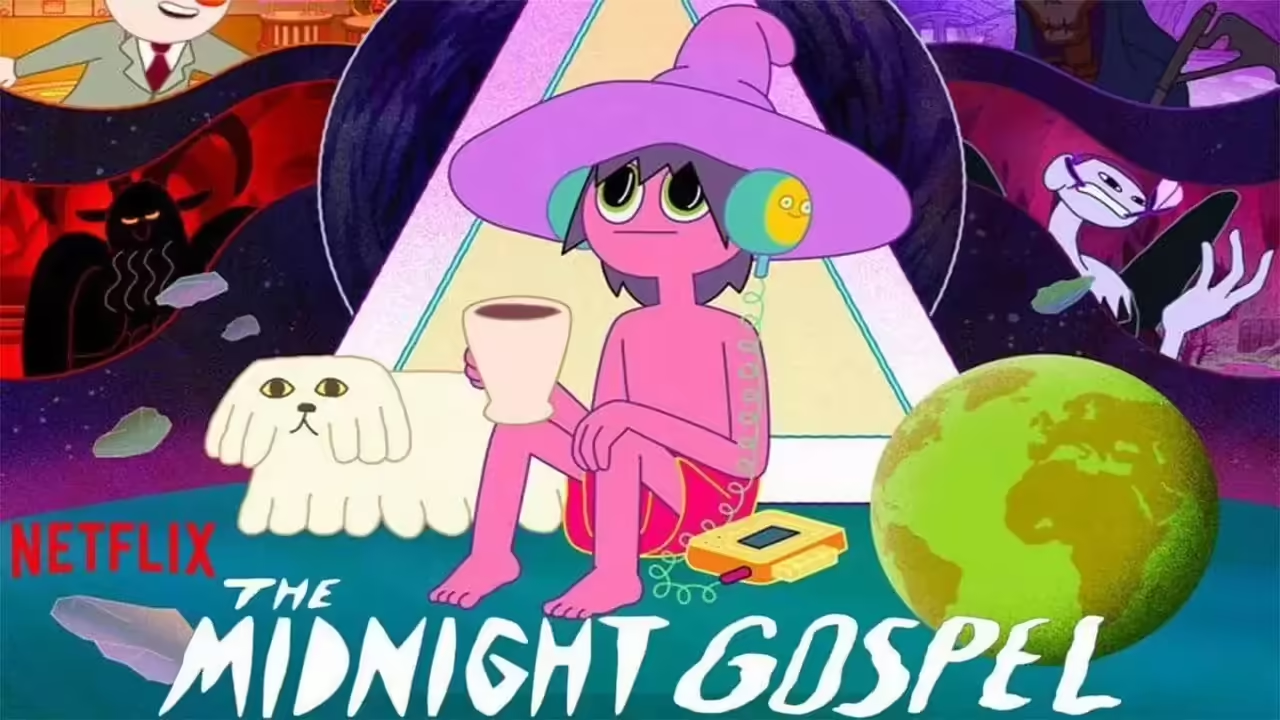
“The Midnight Gospel” is a Netflix original animated series that combines elements of animation and podcasting to create a unique and riveting experience. Created by Pendleton Ward, the creator of “Adventure Time,” and Duncan Trussell, a comedian and podcaster, the series dives into a surreal and philosophical universe as it follows the adventures of Clancy, a space traveler who visits various simulated worlds to interview conscious beings.
The premise of “The Midnight Gospel” is intriguing and original. Clancy, the protagonist, uses a multiverse simulator called “Consciousness Space” to transport himself to different worlds inhabited by creatures of all kinds. In each world, Clancy interviews its inhabitants, who share their knowledge, experiences and reflections on various topics, ranging from life and death, spirituality, drug addiction, meditation, the relationship with suffering and many other aspects of human existence.
While the conversations and dialogue are drawn from actual interviews from Duncan Trussell’s podcast, the animation in “The Midnight Gospel” provides a fascinating and abstract visual layer that complements and amplifies the ideas and concepts discussed. The series combines a variety of visual styles, from psychedelic and abstract to colorful and surreal, creating a visually stimulating and ever-changing world.
This fusion of animation and podcasting is a powerful combination, as it allows the ideas and thoughts expressed in the podcast to come to life in a visually captivating way. Animation provides a creative canvas to explore and represent abstract and complex concepts, making the series accessible and entertaining even for those unfamiliar with the podcast format.
“The Midnight Gospel” stands out for its fearless and courageous approach to tackling deep existential and philosophical themes. Through the conversations and stories of the characters, the series invites the viewer to reflect on life, death, consciousness and the search for meaning in a vast and unknown universe.
The Mind Behind the Series: A Look at Creator Duncan Trussell and His Influence
Duncan Trussell, co-creator of “The Midnight Gospel,” is an American comedian, writer and podcaster known for his unique and philosophical approach to comedy and exploration of existential themes. His eclectic perspective and deep interest in spirituality and consciousness have significantly influenced the creation and narrative of the series.
Trussell is recognized for his podcast called “The Duncan Trussell Family Hour,” in which he interviews a wide range of people, from philosophers and scientists to artists and spiritual leaders. In these episodes, he dives into deep and open conversations that address topics such as meditation, death, psychedelia, spirituality and the nature of reality.
This penchant for exploring the deeper aspects of existence and the universe is clearly reflected in “The Midnight Gospel.” The series is based on dialogue drawn from actual interviews conducted on Trussell’s podcast, and his influence is evident in the topics addressed and the manner in which they are presented.
Through “The Midnight Gospel,” Trussell and co-creator Pendleton Ward have created a platform to amplify and bring to life the ideas and reflections expressed in the podcast. The series’ colorful and surreal animation complements the conversations, allowing abstract and complex concepts to be represented in a visually stimulating and accessible way.
Aside from his work on “The Midnight Gospel,” Trussell has been recognized for his involvement in other projects related to comedy and podcasting. He has been a guest on several television shows, performed stand-up and collaborated with other comedians and artists on creative projects.
The surreal plot of “The Midnight Gospel”: Unraveling the narrative threads
The plot of “The Midnight Gospel” is extremely surreal and takes place in an abstract and constantly changing universe. While it may be puzzling at first, the series’ narrative follows an underlying structure that helps to unravel the threads of the story.
The protagonist of the series is Clancy, a space traveler who uses a multiverse simulator called “Consciousness Space” to visit different simulated worlds. On each world, Clancy interviews conscious beings while experiencing various adventures and challenges. These interviews are actual excerpts of conversations from Duncan Trussell’s podcast.
Although the interviews and conversations seem independent of the main plot, there is a common thread that ties all the episodes together. As the series progresses, it is revealed that Clancy is in search of an object known as the “Crystal Brain,” which can influence reality and change the fate of the worlds he visits.
As Clancy travels from world to world, he encounters surreal and often dangerous situations. These events, while seemingly chaotic in appearance, often reflect deep themes and concepts related to human existence. The series addresses issues such as mortality, spirituality, identity and connection to others.
The narrative of “The Midnight Gospel” does not follow a traditional linear structure, and it is common for the plot to veer into abstract and metaphorical territory. However, as the series progresses, recurring elements can be identified that help to understand the story on a deeper level.
Despite its surreal nature, “The Midnight Gospel” manages to convey a sense of meaning and depth through the conversations and events that take place in each episode. The series invites the viewer to reflect on life, death and the nature of reality, while exploring existential themes in a unique and challenging way.
Clancy’s Interdimensional Journey: Discovering Alien Worlds and Their Meanings
Clancy’s interdimensional journey in “The Midnight Gospel” is a fascinating experience filled with strange worlds, each with its own meaning and symbolism. These simulated worlds feature surreal landscapes and quirky characters representing a wide range of themes and concepts.
Each episode of the series takes Clancy to a different world, where he encounters creatures and sentient beings who share their experiences and reflections. These worlds are full of symbolism and allegory, and often reflect aspects of human existence and the human condition.
For example, in the first episode, Clancy arrives on a world covered in crops and encounters a civilization facing imminent catastrophe. This world represents the fragility of life and the inevitability of death, and the conversations Clancy has with the characters explore themes such as the acceptance of death and the grieving process.
In another episode, Clancy arrives in a seemingly idyllic and colorful world, where the inhabitants are trapped in an endless cycle of violence and war. This world symbolizes the destructive nature of humanity and raises questions about violence, suffering and the search for peace.
Each world in “The Midnight Gospel” presents its own set of challenges and dilemmas for Clancy. Often, these personal challenges reflect the internal struggles and existential questions we face as human beings. Through these experiences, Clancy and viewers are led to question and explore deep themes such as spirituality, identity, consciousness and connection with others.
It is important to note that the alien worlds in “The Midnight Gospel” should not be interpreted literally, but rather as metaphors and symbolic representations of the themes and concepts being explored. Each world offers a unique perspective on life and existence, and as Clancy progresses on his journey, he accumulates a deeper understanding of himself and the world around him.
Philosophical reflections in “The Midnight Gospel”: Existential and spiritual themes
“The Midnight Gospel” is a series that delves into deep philosophical reflections, exploring a wide range of existential and spiritual themes. Through conversations and dialogues drawn from real interviews, the series invites viewers to question and reflect on various aspects of life and consciousness.
One of the recurring themes in the series is death and mortality. The inevitability of death and how to deal with it is addressed, as well as different perspectives on the meaning and purpose of life in relation to our finitude. The conversations in “The Midnight Gospel” explore the various ways people cope with death and find meaning in the midst of impermanence.
Spirituality and connection to something greater than ourselves are also prominent themes in the series. Different spiritual traditions and contemplative practices are explored, such as meditation and the use of psychedelic substances to expand consciousness. These conversations delve into the search for transcendence and understanding the nature of reality and consciousness.
Suffering and acceptance are also topics discussed in “The Midnight Gospel.” The different ways in which people experience suffering and how to find a healthy relationship with pain and suffering in life are explored. Issues of acceptance, forgiveness and personal transformation through hardship are addressed.
The series raises questions about identity and the nature of the self. It questions the idea of who we really are and how identity can be fluid and changing. Concepts related to the interconnectedness of all things and the illusion of separation are also explored.
These philosophical reflections in “The Midnight Gospel” are imbued with an open and respectful approach to different perspectives and beliefs. The series invites contemplation and dialogue, presenting a wide range of ideas and viewpoints for viewers to reflect upon and form their own conclusions about the existential and spiritual themes presented.
Art style and visual design in the series: A visual feast for viewers
The art style and visual design of “The Midnight Gospel” are truly impressive and create a visual feast for viewers. The series combines a variety of visual styles, from psychedelic and abstract to colorful and surreal, creating a visually stimulating and constantly changing world.
Each world Clancy immerses himself in is meticulously designed, with an attention to detail and an overflowing imagination. The landscapes and scenery are vibrant and full of life, featuring a wide range of colors and shapes that draw the eye. These visual designs capture the essence of each world and reinforce the themes and concepts explored in each episode.
The use of animation in “The Midnight Gospel” is also impressive. The fluid transitions and visual transformations create a sense of fluidity and constant movement, adding an additional layer of visual fascination to the series. Animation is creatively used to depict abstract and complex concepts, taking the viewer on a visually stimulating and captivating journey.
In addition, the character design in “The Midnight Gospel” is unique and eye-catching. Each character has a distinctive and often quirky appearance, reflecting their personality and role in the narrative. From anthropomorphic beings to bizarre and abstract creatures, the characters in the series are full of imagination and creativity.
The combination of art style, visual design and animation in “The Midnight Gospel” creates an immersive and immersive audiovisual experience. Viewers are transported into a surreal universe and find themselves constantly surprised by the visual stimuli and captivating images presented on screen.







